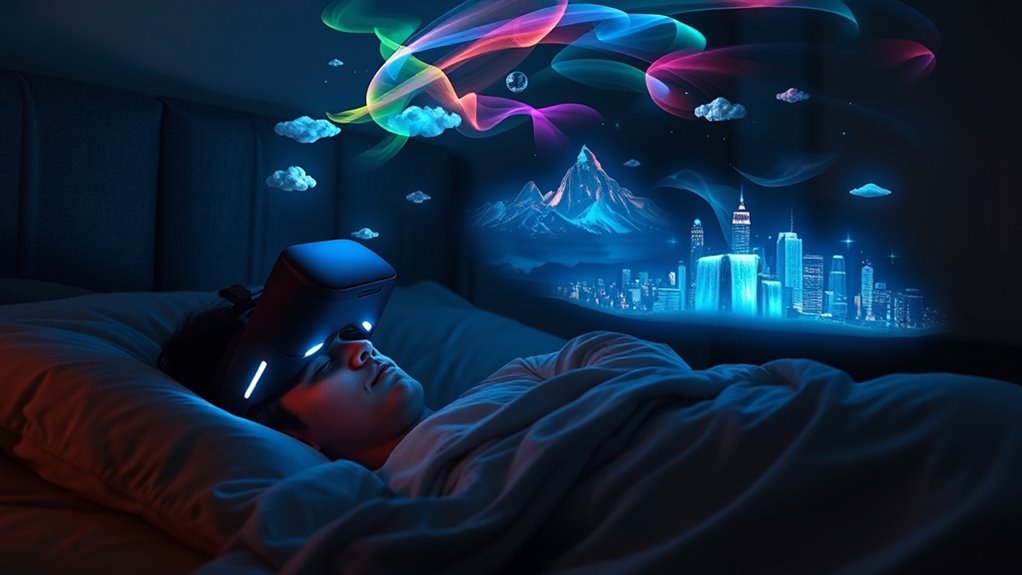When you use VR, your brain processes immersive visual, auditory, and tactile stimuli as if they’re real. Over time, neural adaptation allows these virtual sensations to be integrated into your memory and subconscious, influencing your dreams. You might find virtual worlds appearing in your sleep, with vivid landscapes or scenarios from your virtual sessions. As VR’s impact grows, understanding how these simulated experiences invade dreams becomes more important—discover how this fascinating connection works as you explore further.
Key Takeaways
- VR experiences can be integrated into dreams due to neural plasticity and sensory memory retention.
- Virtual stimuli from VR sessions often influence dream content, creating vivid, surreal virtual landscapes.
- Immersive sensations in VR can linger after sessions, extending their impact into sleep and dream narratives.
- Emotional reactions to virtual worlds during VR can evoke strong feelings within dreams.
- As VR technology advances, its influence on subconscious and dream experiences is likely to grow more profound.

Imagine stepping into a virtual world so immersive that it blurs the line between dreams and reality. As you wear a VR headset, your brain begins to process an array of immersive sensations—visuals, sounds, and even tactile feedback—that feel incredibly real. Over time, your neural adaptation kicks in, allowing your brain to adjust to these stimuli as if they were genuine experiences. This neural plasticity means that your mind becomes more adept at integrating virtual elements into your perception of reality, making the virtual environment feel seamless and convincing. When you eventually close your eyes to sleep, these heightened sensory memories don’t simply fade away; they often linger, weaving themselves into your dreams.
During sleep, your brain continues to process recent experiences, and the vividness of virtual reality sessions can influence the nature of your dreams. If you’ve spent hours exploring fantastical worlds or engaging in intense virtual scenarios, your subconscious may incorporate these sensations into your dreamscape. This blending of virtual stimuli and natural dreaming creates a surreal experience where the boundaries between the simulated environment and your internal imagination become increasingly porous. You might find yourself reliving virtual adventures or encountering familiar virtual landscapes within your dreams, sometimes with startling clarity. The neural adaptation that occurred during your immersive sessions primes your brain to retain these sensations, making the virtual elements feel authentic even during sleep. Additionally, neural plasticity plays a crucial role in how these memories are integrated and retained, influencing your dream content.
Dreams may incorporate vivid virtual experiences, blending digital worlds with your subconscious for startlingly realistic nocturnal adventures.
This phenomenon raises intriguing questions about how virtual reality can shape your subconscious. The immersive sensations you experience in VR do more than just stimulate your senses temporarily—they can forge lasting impressions that influence your dreams long after you’ve taken off the headset. Your brain’s ability to adapt to these stimuli means that virtual environments can become embedded in your subconscious landscape, sometimes leading to vivid, almost hyper-realistic dreams. These dreams can evoke strong emotions or nostalgia, especially if the virtual worlds hold personal significance or are particularly immersive.
In essence, virtual reality doesn’t just end when you wake up—it can extend into your sleep, creating a continuous loop of immersive experience. Your neural adaptation ensures that the sensations felt in VR aren’t quickly forgotten but are woven into your dream narratives. This interplay between virtual stimuli and sleep underscores how powerful and lasting the impact of immersive sensations can be. As VR technology advances, understanding this connection will be vital, especially as more people seek to explore virtual worlds that can influence their subconscious long after the screens go dark.
Frequently Asked Questions
Can VR Dreams Be Controlled or Manipulated Intentionally?
You can potentially control or manipulate VR dreams through techniques like lucid dreaming and sensory integration. Lucid dreaming lets you become aware you’re dreaming, giving you the power to steer your dream experiences intentionally. By practicing sensory integration, you can enhance dream control, making it easier to influence virtual elements within your dreams. With focus and effort, you might direct your VR dreams to explore desired worlds or scenarios consciously.
Do VR Dreams Impact Our Real-World Perceptions?
Your VR dreams can impact your real-world perceptions by causing perception shifts and affecting sensory integration. When your mind processes simulated experiences during sleep, it may alter how you interpret real-world stimuli. This means you might start perceiving things differently or feel more connected to virtual environments. These effects highlight how powerful your subconscious can be in blending virtual experiences with your daily perception of reality.
Are VR Dreams More Vivid Than Natural Dreams?
Your dreams are like vivid paintings, and VR dreams often outshine natural ones. You might find that VR dreams have higher sensory intensity, making them feel more real. This heightened vividness can boost dream recall, as your mind clings to these intense impressions. While natural dreams can be equally vivid, VR dreams tend to be more immersive, blurring the line between reality and imagination, leaving a lasting impression on your subconscious mind.
How Often Do Vr-Induced Dreams Occur?
You might wonder how often VR-induced dreams happen. While they’re not extremely common, frequent exposure to virtual reality can increase dream recall of these vivid, simulated worlds. However, VR experiences can sometimes cause sleep disruption, making it harder to achieve restful sleep and potentially affecting dream patterns. If you notice more vivid or unusual dreams after VR use, it’s likely linked to how your brain processes these immersive experiences during sleep.
Can VR Dreams Cause Psychological or Emotional Issues?
You might wonder if VR dreams could cause emotional or psychological issues. While there’s limited research, some studies suggest that intense VR dreams can impact emotional resilience and memory consolidation, especially if they evoke strong feelings or vivid imagery. If you frequently experience such dreams, it’s wise to monitor your mental health and seek support if emotions become overwhelming, as unresolved distress could influence your overall well-being.
Conclusion
As you drift into sleep tonight, you wonder—will the boundaries between your virtual dreams and reality blur? The line between the simulated worlds and your subconscious begins to fade, leaving you unsure where one ends and the other begins. Could these immersive dreams hold secrets you’re not meant to uncover? Or will they simply become the next frontier of your mind’s uncharted territory? Sleep tight, but stay alert—what’s waiting in those virtual shadows might surprise you.









